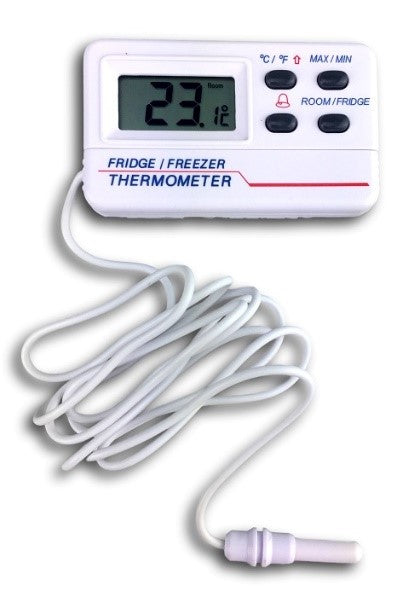Ever set the temperature dial on your fridge to four degrees but found that your milk spoilt prematurely or formed ice crystals? Your fridge’s temperature setting may not have matched the temperatures reached or maintained on the inside. The right way to diagnose and correct this problem requires a fridge thermometer.
Why have a fridge thermometer?
Fridge thermometers are small, easy-to-use and cost-effective devices that help monitor the temperature of a fridge or freezer when in use. They are an increasingly important means by which many businesses can monitor and record fridge temperatures as part of their Hazard Analysis and Critical Control Point (HACCP) plans. They are also handy to have around the home to monitor and manage the performance of your fridge.
The two key reasons why you measure the temperature of a fridge are;
- Food spoilage: If not chilled properly, dairy products, meats, fruits and vegetables will spoil at a faster rate than they would if stored in the correct temperature zone.
- Foodborne Illness. Less than 5°C and more than 60°C is the safe temperature zone for food. Outside these zones, food poisoning bacteria, which may be present in the food, can multiply to dangerous levels.
Knowing the actual internal temperature of your fridge enables you to make informed decisions on any temperature adjustments or fridge maintenance that’s required.
How to use a fridge thermometer
Simply purchasing a thermometer and placing it in the fridge will not guarantee you will be monitoring safe temperatures. This problem is due to inherit temperature variations known to occur within fridges and freezers.
Depending on your fridge’s cooling mechanism and design, there will be cooler and warmer areas within the unit. Typically, the warmest areas within a fridge are the doors and the top shelf. The back wall and bottom shelves are cooler.
To get an accurate representation of the internal average temperature of your refrigerator, we recommend you to take measurements just below the top shelf, in the middle or closer to the door. If your fridge’s temperature is reading a couple of degrees warmer than it should be, you may need to reduce the temperature. If it's significantly cooler, you may want to increase it.
It may take a few adjustments to get it right. You may also need to readjust settings between the warmer and cooler months of the year.
|
Instrument Choice Scientist Tip: If you are using an internal sensor with an external LCD, check that the length of the cord is suitable for the location you wish to place the sensor |
Examples of Fridge Thermometers
Digital Thermometer for Fridge or Freezer
Key features:
A popular, reliable thermometer that records and displays the current internal and external fridge temperature. Its design incorporates a programmable alarm that is activated when fridge temperatures move outside your preset limits.
Applications:
A suitable device for home use as well as commercial environments with frequent fridge access.
Specifications:
Min/Max Temperature Recording: Yes
Alarms: Yes - Preset
External LCD: Yes
Accuracy: ±1°c
Sensor Cord Length: 1 metre
Check fridge Remote Sensor Thermometer
Key features:
Contains magnets for easy placement on a metal surface and delivers high accuracy measurements over a wide temperature range. The thermometer’s unique CAL Check allows for the calibration of the device.
Applications:
Popular for monitoring ideal for monitoring home and commercial food care fridge environments.
Specifications:
Min/Max Temperature Recording: Yes
Alarms: No
External LCD: Yes
Accuracy: ± 0.3°c
Sensor Cord Length: 1 metre
Certified Alarm Thermometer
Key features:
The internal sensor on this thermometer measures ambient air temperature and the external sensor monitors the temperature inside freezers, refrigerators, or cold holding display cases.
The external sensor has a 3-meter cable and a stainless steel, blunt probe enclosed in a sealed plastic bottle of propylene glycol, a solution that is GRAS (Generally recognised as safe).
This sensor enclosed in the buffer solution ensures accurate measurements that are not impacted by rapid temperature fluctuations such as opening and closing doors.
Applications:
Recommended for professional use including restaurant kitchens, food manufacturing and processing.
Specifications:
Min/Max Temperature Recording: Yes
Alarms: Yes
External LCD: Yes
Sensor Cord Length: 3 metres
Accuracy: ±0.5°c
Conclusion
An easy way to help prevent the inconvenience of food spoilage and manage food-related health and safety issues is with the proper use of a fridge thermometer.
There's a range of cost-effective devices for use in the home that will monitor the internal environment of your fridge with ease. Similarly, there is a wide variety of thermometers that are designed to help you manage your workplace HACCP plan. These instruments will enable you to accurately record and prove that you have maintained foodstuffs within an ideal temperature range in your fridges, freezers and coolrooms. If not, your thermometer readings will indicate where and how you need to apply corrective action. See more fridge thermometers.
Do you have any questions about fridge thermometers? Want to know more about fridge thermometers for the home or work? Contact one of our friendly Scientists. We’re here to help! Phone 1300 737 871 or email customer-service@instrumentchoice.com.au.


